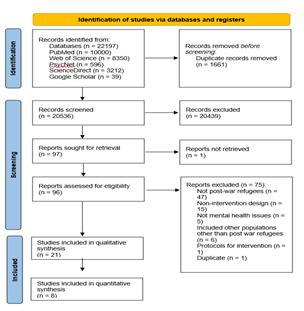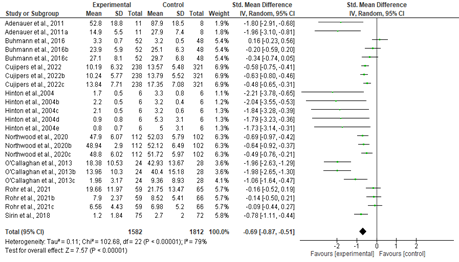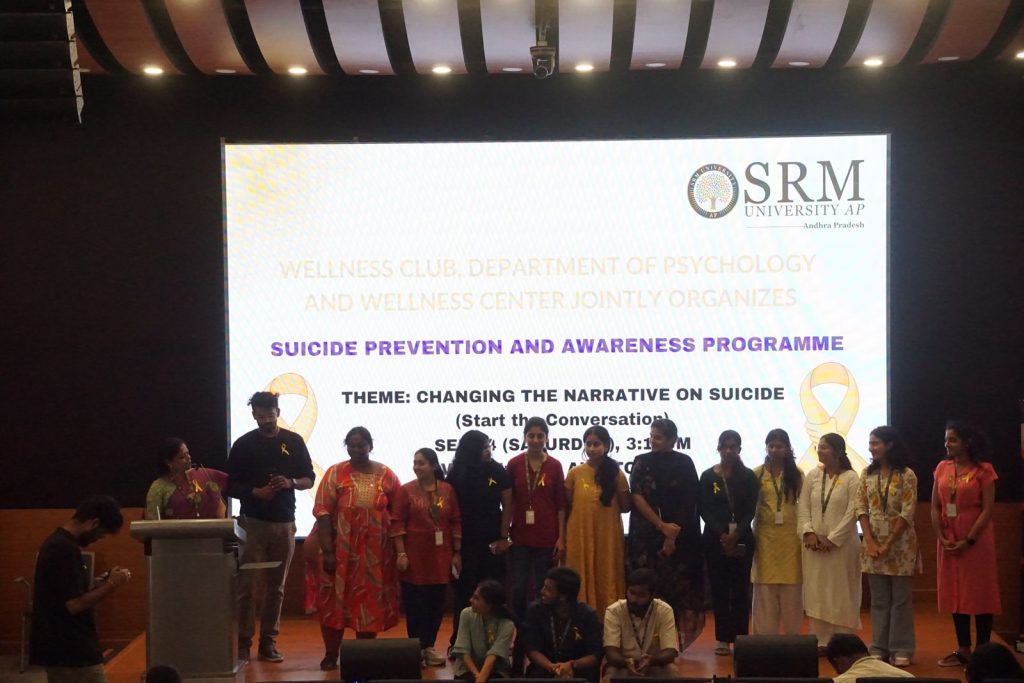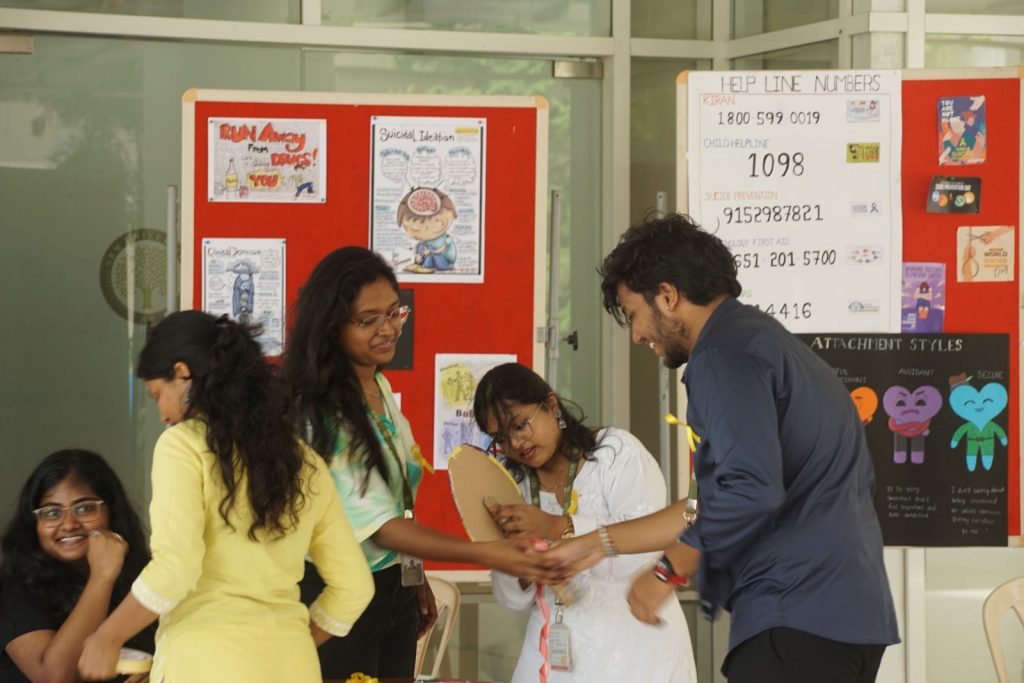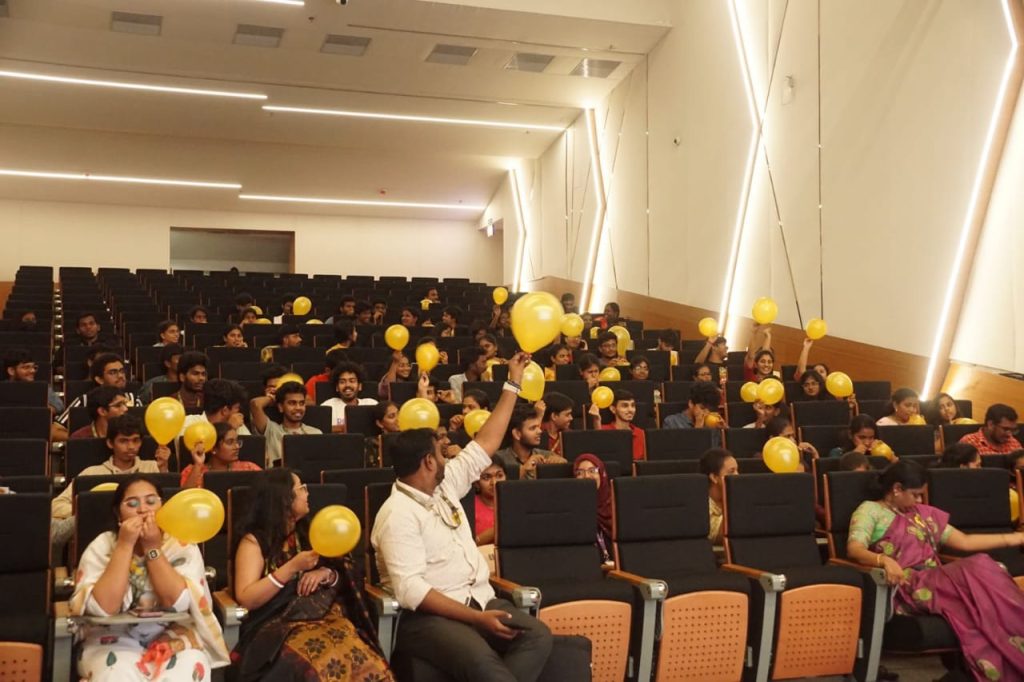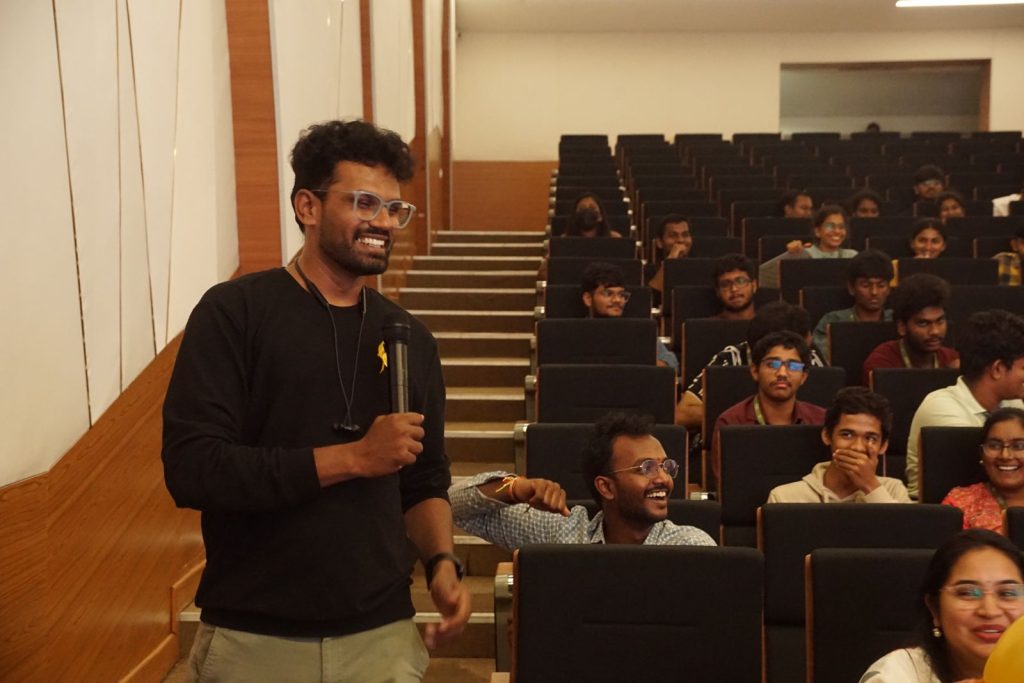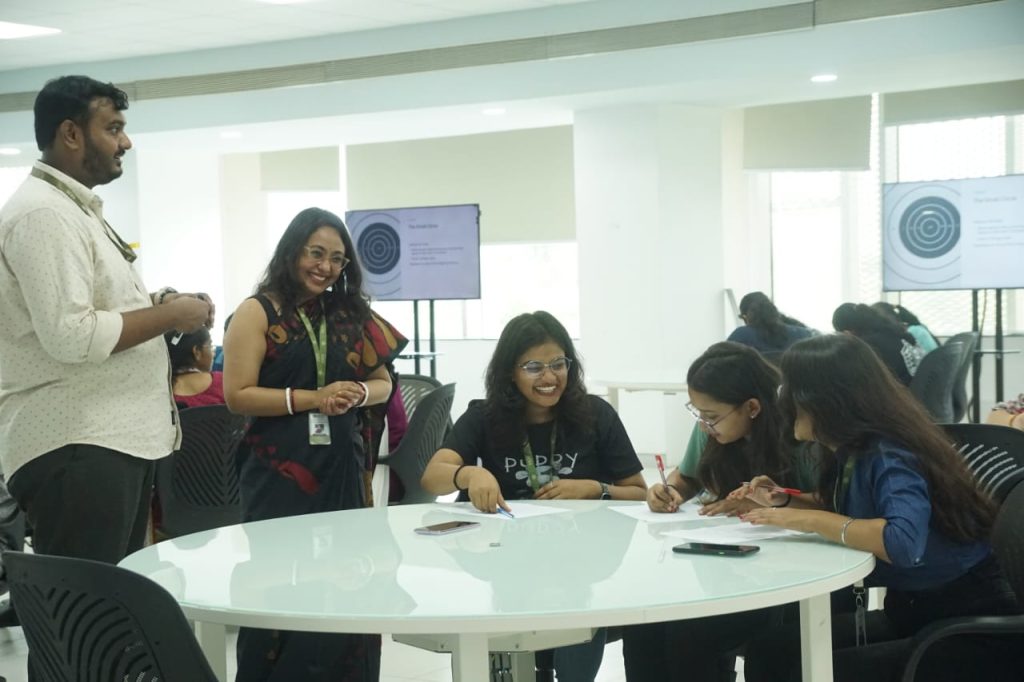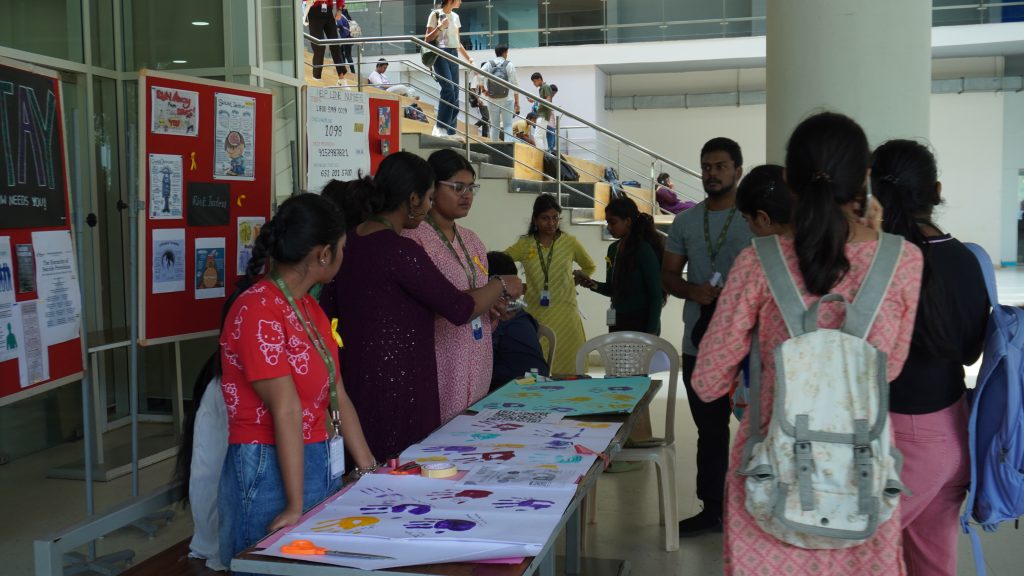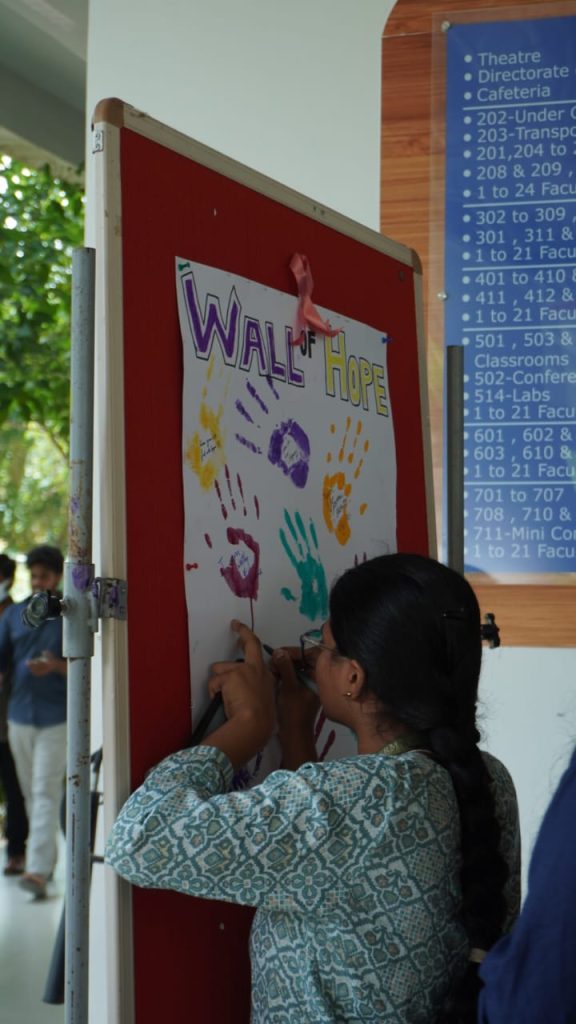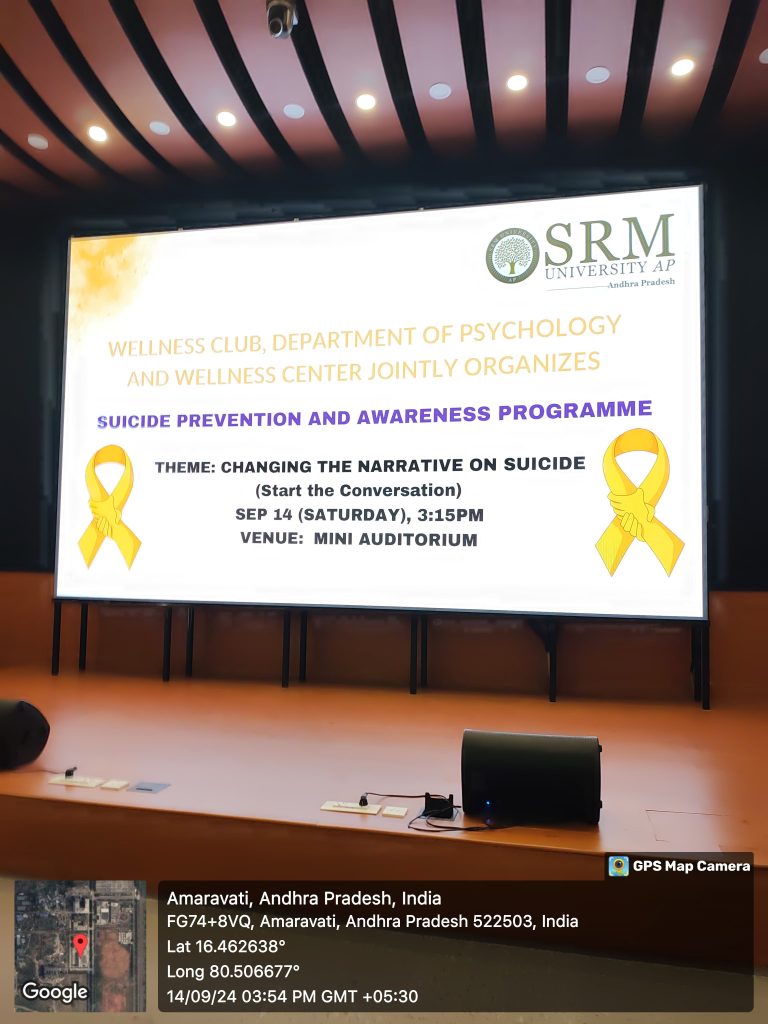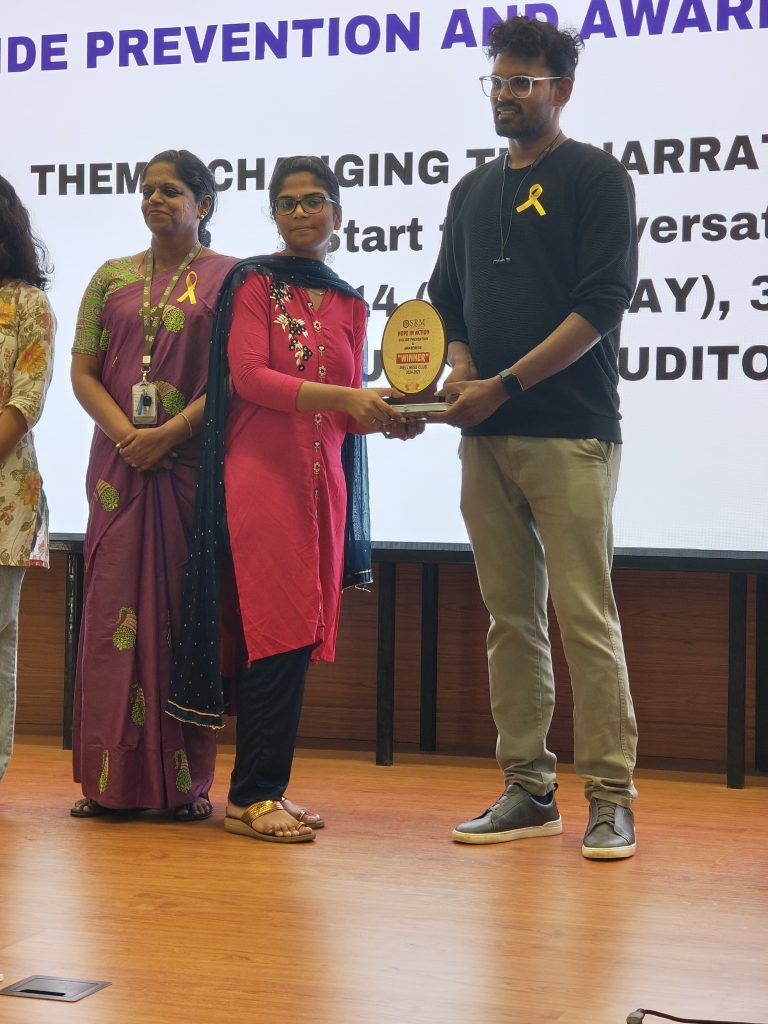Understanding Adolescent Stress through Psychosocial Factors
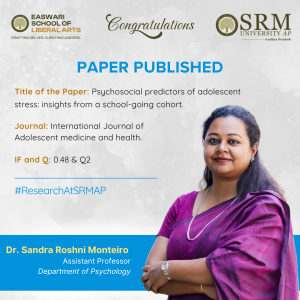 While the saying – ‘School time is the best time in a child’s life,’ would have been true years ago, it no longer reflects the current scenario among school-going adolescents. Today, children in school can be under just as much stress and burden as a fully grown adult. Though factors like academic pressure, social expectations, and family dynamics mattered even earlier, today these factors have developed a new-found intensity, and when topped with the hormonal changes, can adversely affect an adolescent, making their life challenging. Dr Sandra Roshni Monterio, Assistant Professor at the Department of Psychology, analyses the situation through her paper titled Psychosocial predictors of adolescent stress: insights from a school-going cohort.
While the saying – ‘School time is the best time in a child’s life,’ would have been true years ago, it no longer reflects the current scenario among school-going adolescents. Today, children in school can be under just as much stress and burden as a fully grown adult. Though factors like academic pressure, social expectations, and family dynamics mattered even earlier, today these factors have developed a new-found intensity, and when topped with the hormonal changes, can adversely affect an adolescent, making their life challenging. Dr Sandra Roshni Monterio, Assistant Professor at the Department of Psychology, analyses the situation through her paper titled Psychosocial predictors of adolescent stress: insights from a school-going cohort.
Brief abstract
This study investigates the psychosocial factors influencing stress among 1,104 school-going adolescents in Telangana, India. Utilising the Adolescence Stress Scale and various psychosocial measures, hierarchical multiple regression and serial mediation analyses revealed that emotional instability, ill health experiences, conscientiousness, and psychosocial support significantly predict adolescent stress, explaining 6% of the variance. Serial mediation models highlighted family health and emotional efficacy as key mediators. The findings underscore the complex interplay of psychosocial factors in adolescent stress and suggest targeted interventions focusing on emotional regulation and family health to mitigate stress.
Explanation of the Research in Layperson’s Terms
Adolescence is a time of big changes, and while this is true globally, Indian school-going children may experience these changes differently because of our unique cultural and social expectations. This research looks at why teenagers feel stressed and what factors contribute to it. We studied over 1,100 students from schools in Telangana, India, to understand how things like their personality, family life, and social support affect their stress levels. We found that feeling emotionally unstable, having health problems, being overly responsible, and even the kind of support they get from others can increase stress. In fact, too much social support, especially when it’s uninvited or feels controlling, can make adolescents feel even more overwhelmed. This is particularly relevant in India, where family bonds are strong but can sometimes come with pressure, judgment, or expectations. Additionally, the turn to virtual dependency may be temporarily comforting but may not always translate to meaningful connection leading to greater feelings of isolation.
Together, these factors explain a small but important part of why teens feel stressed. We also discovered that a healthy family environment and the ability to manage emotions can help reduce stress. This means that helping teens cope with their emotions and supporting strong family relationships could make them feel less stressed.
Despite growing awareness about teen mental health, most Indian studies have focused only on academic stress or used Western tools that may not capture the emotional landscape of Indian adolescents. Our study fills this gap by using tools grounded in Indian cultural realities and examining the “how” and “why” behind stress, not just “how much” stress exists.
In short, Indian children face a mix of visible and invisible pressures. To truly support them, we need to look beyond grades, listen without judging, and create spaces, both online and offline, where they feel safe, heard, and understood.
Practical Implementation or Social Implications:
The findings from this study have practical implications for schools, families, and mental health professionals. By identifying emotional instability and ill health as key stress contributors, schools can implement programs teaching emotional regulation skills to help adolescents manage stress. The significant role of family health suggests that family-based interventions, like workshops promoting positive parent-child communication, could reduce teen stress. Additionally, the findings challenge the assumption that more social support is always better, suggesting the quality of support matters more than quantity, especially in cultures undergoing social transition. There is a need for tailored support that respects adolescents’ desire for independence. These insights can inform policies in educational and community settings to foster environments that reduce stress and promote mental well-being among teenagers, particularly in high-pressure cultural contexts like India.
Collaborations:
This study was a collaborative effort between SRM University-AP, GITAM University, Hyderabad Campus, and Centre for Health Psychology, University of Hyderabad
Future Research Plans:
Building on these findings, our future research will focus on practical and achievable steps to deepen our understanding of adolescent stress. We plan to develop culturally grounded interventions to improve family health and adolescent emotional efficacy, tailored to the Indian context. To address the modest explained variance, we will explore a limited set of additional factors, such as academic pressure and peer relationships.
- Published in Departmental News, News, Psychology News, Research News
A Meta Analysis on the Mental Health of War Refugees
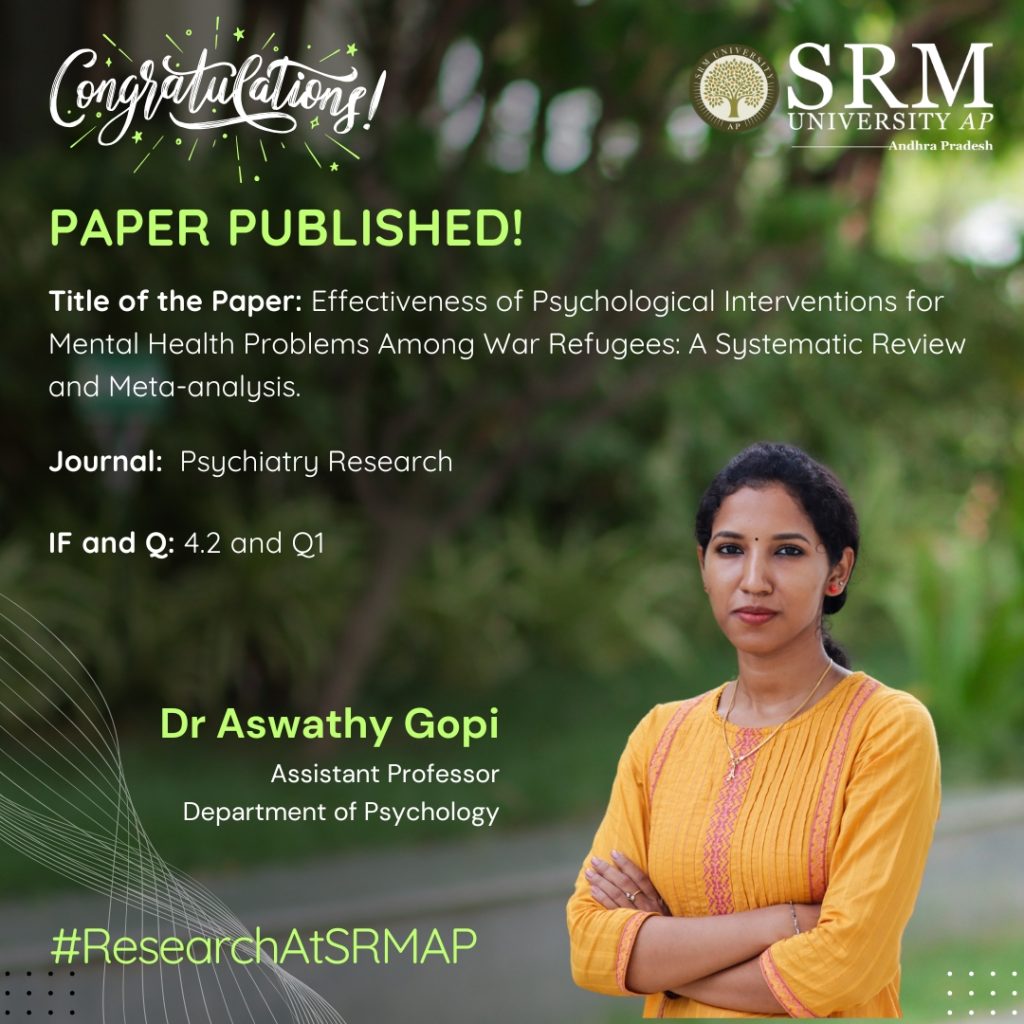 “I object to violence because when it appears to do good, the good is only temporary; the evil it does is permanent.”, this quote by Mahatma Gandhi serves as a stark reality that war leaves individuals grappling in severe trauma. Dr Aswathy Gopi, an Assistant Professor at the Department of Psychology, explores this impact in her research paper titled “Effectiveness of Psychological Interventions for Mental Health Problems Among War Refugees: A Systematic Review and Meta-Analysis.” Her paper sheds light on the profound effects of war on the mental health of refugees, emphasising the need for tailored approaches to support their psychological well-being.
“I object to violence because when it appears to do good, the good is only temporary; the evil it does is permanent.”, this quote by Mahatma Gandhi serves as a stark reality that war leaves individuals grappling in severe trauma. Dr Aswathy Gopi, an Assistant Professor at the Department of Psychology, explores this impact in her research paper titled “Effectiveness of Psychological Interventions for Mental Health Problems Among War Refugees: A Systematic Review and Meta-Analysis.” Her paper sheds light on the profound effects of war on the mental health of refugees, emphasising the need for tailored approaches to support their psychological well-being.
Abstract:
War and displacement have led to a global mental health crisis, with 117.3 million individuals displaced and one in five refugees experiencing psychological distress. Despite the availability of psychological interventions, their overall effectiveness remains unclear. This systematic review and meta-analysis evaluate the impact of psychological interventions on war refugees’ mental health. A comprehensive search of PubMed, Web of Science, APA PsycNET, ScienceDirect, and Google Scholar (July 2024) identified 21 studies for systematic review and eight randomized controlled trials for meta-analysis. The results indicate a significant medium effect size of psychological interventions (SMD = -0.69, 95% CI: -0.87, -0.51, p < .00001), with in-person interventions showing a large effect (SMD = -1.03) and telehealth interventions demonstrating a small effect (SMD = -0.44) in reducing the mental health issues among war refugees. Findings support the effectiveness of psychological interventions, emphasizing the need for further research on digital mental health solutions to enhance accessibility for war refugees.
Explanation in layperson’s terms
War forces millions of people to leave their homes, and many of them experience severe stress, anxiety, and depression. In fact, one in five refugees struggles with serious mental health problems. While various psychological therapies exist to support them, it is unclear how effective they truly are. The current review identified the available in-person as well as telehealth-based psychological interventions that help war refugees in addressing their mental health conditions using evidence from 21 studies. A statistical examination of eight high-quality trials found that psychological support significantly helps refugees in reducing mental health issues. Although face-to-face therapy was reported to be the most effective, online therapy also demonstrated positive results, with a smaller effect. Given the limited number of studies on digital interventions, further research is warranted due to factors like displacement and limited healthcare resources of war refugee.
Practical Implementation and Social Implications
Psychological interventions involving both in-person and telehealth showed effectiveness for mental health problems among war-refugees. Policy makers and intervention developers should provide keen attention while designing interventions for mental health issues of war refugees as their challenges are distinct from other refugees and the general population. Further, the government and healthcare authorities can aim for adopting hybrid models integrating both telehealth and in-person interventions for the effective management of mental health problems of war refugees.
Collaborations
This secondary analysis was conducted in collaboration with Indian Institute of Technology Bhilai, Chhattisgarh.
Future research plans
Dr Aswathy Gopi is currently working on positive organisational health, with several research works under review in reputed high-impact journals. The research primarily explores organisational effectiveness and mental health outcomes across various populations. She is also collaborating with IITs and central universities to conduct both primary and secondary research in this domain.
The link to the article
https://doi.org/10.1016/j.psychres.2025.116432
- Published in Departmental News, News, Psychology News, Research News
Trio Publish Patent on VR Based Therapy Systems
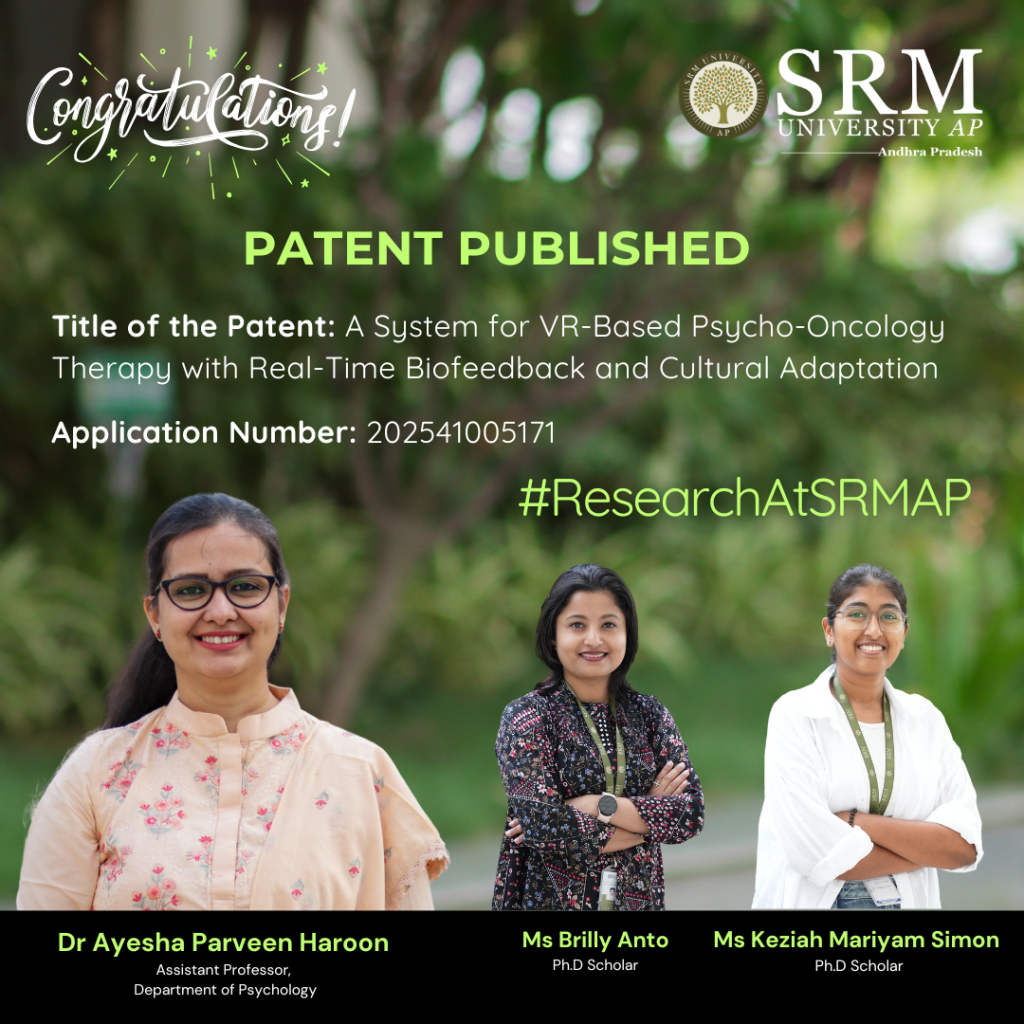 The Department of Psychology at SRM University-AP is proud to announce the publication of the patent titled, “A System for VR-Based Psycho-Oncology Therapy with Real-Time Biofeedback and Cultural Adaptation” by Dr Ayesha Parveen Haroon and her Research Scholars-Ms Brilly Anto and Ms Keziah Mariyam Simon. This groundbreaking research introduces a virtual reality therapy system that integrates real-time biofeedback.
The Department of Psychology at SRM University-AP is proud to announce the publication of the patent titled, “A System for VR-Based Psycho-Oncology Therapy with Real-Time Biofeedback and Cultural Adaptation” by Dr Ayesha Parveen Haroon and her Research Scholars-Ms Brilly Anto and Ms Keziah Mariyam Simon. This groundbreaking research introduces a virtual reality therapy system that integrates real-time biofeedback.
Abstract
This research introduces a VR-based psycho-oncology therapy system that integrates real-time biofeedback and cultural adaptation to enhance the psychological well-being of cancer patients. The system utilizes virtual reality to create immersive therapeutic environments while continuously monitoring physiological indicators such as heart rate variability (HRV), skin conductance response (GSR), and respiratory rate to assess stress levels in real time. A processing unit analyzes this data using stress detection algorithms and selects personalized therapeutic interventions, including guided imagery, music therapy, mindfulness practices, and culturally relevant content. The system adapts dynamically to patient responses, ensuring an individualized approach to mental health support. Additionally, a cloud-based module securely stores therapy metrics for long-term monitoring and personalized care adjustments. This innovation offers a patient-centred, technology-driven intervention that enhances mental health outcomes, improves treatment adherence, and provides accessible psychological support for cancer patients in both clinical and home settings.
Explanation in layperson’s terms.
Cancer treatment can be emotionally challenging, leading to stress, anxiety, and depression. This research introduces a Virtual Reality (VR)-based therapy system that helps patients relax and manage stress through immersive environments like calming landscapes and guided meditation. The system monitors heart rate, breathing, and stress levels in real time and automatically adjusts therapy by playing soothing music, guided imagery, or relaxation exercises. It also includes culturally relevant content, making therapy more personalized and accessible, even for patients in remote areas. In short, this system acts as a virtual therapist, offering personalized mental health support to cancer patients during treatment and recovery.
Practical Implementation & Social Impact
Practical Implementation
Used in hospitals, cancer centers, and home-based care for stress management.
Helps psycho-oncologists and mental health professionals provide personalized therapy.
Supports palliative care and extends telehealth access to remote areas.
Social Implications
• Reduces stress and anxiety in cancer patients, improving their quality of life.
• Increases accessibility to mental health support, especially in underserved areas.
• Enhances treatment adherence by promoting emotional well-being.
• Offers culturally relevant therapy, making interventions more relatable and effective.
This system bridges the gap in psycho-oncology care, making mental health support more engaging, accessible, and personalized.
Future Research Plans
• Enhancing VR therapy with AI-driven personalization.
• Integrating EEG-based biofeedback for stress monitoring.
• Developing affordable, portable VR solutions for remote care.
• Conducting clinical trials for validation.
• Expanding telehealth access for home-based psycho-oncology care.
- Published in Departmental News, News, Psychology News, Research News
Exploring the Complexities of Victim Profiling
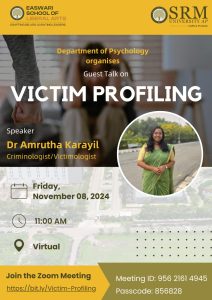 In an era where crime rates and societal concerns about safety have significantly heightened, understanding the psyche of offenders and the dynamics of victimisation has never been more crucial. The Department of Psychology at the Easwari School of Liberal Arts organised an enlightening guest talk delivered by Dr Amrutha Karyil, an expert in Crimes against Women and Children, Victimology, and Victim Assistance. Dr Karyil’s insightful discourse shed light on the complex world of victim profiling, engaging students in a thought-provoking discussion about its historical evolution, methodologies, and ethical dimensions.
In an era where crime rates and societal concerns about safety have significantly heightened, understanding the psyche of offenders and the dynamics of victimisation has never been more crucial. The Department of Psychology at the Easwari School of Liberal Arts organised an enlightening guest talk delivered by Dr Amrutha Karyil, an expert in Crimes against Women and Children, Victimology, and Victim Assistance. Dr Karyil’s insightful discourse shed light on the complex world of victim profiling, engaging students in a thought-provoking discussion about its historical evolution, methodologies, and ethical dimensions.
Dr Karyil in her presentation offered a fascinating overview of the history of profiling, tracing its roots back to the Salem Witch Trials and the harrowing case of Jack the Ripper. She elaborated on how profiling serves as a form of behavioural evidence analysis, focusing on the crucial intersection of psychology and criminal investigations. By examining crime scenes, victim backgrounds, and the modus operandi of offenders, profiling seeks to narrow the suspect pool, providing law enforcement with valuable insights into potential perpetrators.
During the talk, Dr Karyil detailed five major types of profiling: psychological, suspect-based, geographical, crime scene, and equivocal death analysis. She stressed that while profiling can be an invaluable investigative tool, it is by no means definitive. Rather, it aids in understanding the underlying patterns of criminal behaviour and assists investigators in their pursuit of justice.
Dr Karyil further explored the broader implications of victim profiling in crime scene analysis. She shared compelling statistics and characteristics of victims targeted by notorious serial killers, urging attendees to recognise the patterns and signatures that often reveal themselves in such cases. The talk underscored the necessity of fostering awareness and specialised training in addressing severe offences, reflecting on the ethical responsibilities that come with careers in forensic psychology.
The event also served as a catalyst for vibrant discussions about the ethical challenges. Students expressed their interest in diverse career paths such as crime scene analysis, offender profiling, and counselling within the criminal justice system. Dr Karyil’s expertise and engaging delivery inspired many to consider how they might contribute to this vital area of society, whether through research, advocacy, or direct service.
- Published in Departmental News, News, Psychology News
Department of Psychology and the Wellness Centre Partner for Mental Health Awareness Programme
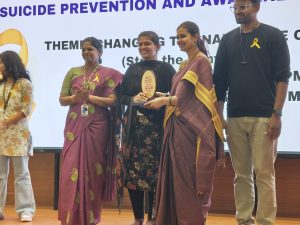 The Wellness Club under the Department of Psychology, in collaboration with the Wellness Center at SRM University-AP, hosted a mental health awareness programme aimed at undergraduate students on September 14, 2024. The initiative focused on raising awareness about mental health and suicide prevention while promoting a supportive campus environment for the students.
The Wellness Club under the Department of Psychology, in collaboration with the Wellness Center at SRM University-AP, hosted a mental health awareness programme aimed at undergraduate students on September 14, 2024. The initiative focused on raising awareness about mental health and suicide prevention while promoting a supportive campus environment for the students.
University counsellors Ms Mohua Das, Ms Alekhya Sankara, and Mr Joel Kristof Gibbs played a pivotal role in the programme, leading discussions and workshops on the emotional and psychological challenges students may face. They addressed critical issues like stress management, anxiety, and crisis intervention, highlighting their extensive experience in supporting students’ mental wellness.
The programme’s objectives included reducing the stigma surrounding mental health issues, encouraging open conversations, and equipping students with tools to recognise warning signs of suicide. Interactive activities, such as the Wall of Hope and Emotional Wheel, engaged participants in expressing hope and reflecting on their emotions.
In addition to discussions, an Art Therapy Workshop provided a creative outlet for attendees, teaching grounding techniques for emotional healing. Students also showcased their creativity through poetry and digital art competitions, with themes centred on hope, resilience, and suicide prevention.
An information booth offered attendees resources on mental health support systems and coping strategies. The event concluded with a Valedictory Ceremony, where reflections on the day were shared, and prizes were awarded to competition winners.
Participants left feeling empowered and equipped with valuable tools to support their mental well-being and that of their peers. This initiative marks a significant step in SRM University-AP‘s commitment to fostering a supportive and safe environment for student mental health. As mental wellness continues to be a priority, the varsity encourages ongoing participation in mental health initiatives to further enhance awareness and support across the campus.
- Published in Departmental News, News, Psychology News, student affairs news
Fishing Community Perspectives: NAOP Convention Insights
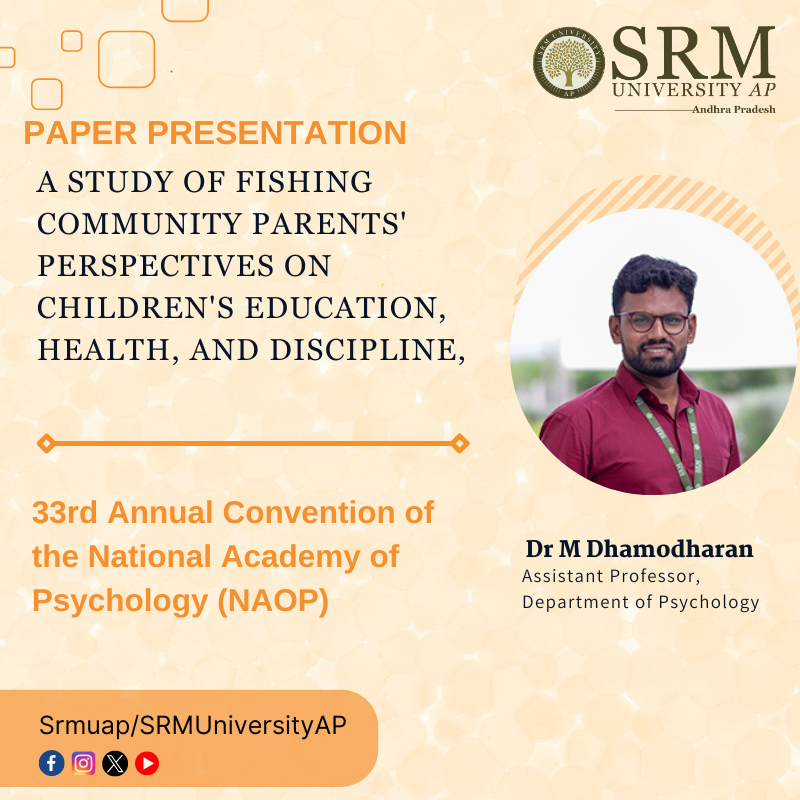
The Department of Psychology at SRM University-AP is pleased to announce Dr Dhamodharan’s pivotal insights, which surfaced at the culmination of the 33rd Annual Convention of the National Academy of Psychology (NAOP), orchestrated by the Department of Applied Psychology at GITAM School of Humanities and Social Sciences, Vishakhapatnam. Dr Dhamodhran, Assistant Professor at the Department of Psychology published his paper, titled “A Study of Fishing Community Parents’ Perspectives on Children’s Education, Health, and Discipline,” which has received profound attention for its insightful analysis.
Abstract:
The Sustainable Development Goals (SDGs) prioritise addressing poverty, promoting good health, and ensuring quality education, among other objectives. However, coastal villages often experience profound socio-economic, financial, and educational disadvantages, leading to recurring financial hardships. The literacy levels within fishing communities are notably deficient, exacerbating challenges in accessing fundamental amenities such as clean drinking water, adequate shelter, educational opportunities, and general well-being. The pervasive poverty and vulnerability prevalent in these areas significantly impede children from fishing villages from regularly attending school, thereby impacting their overall health, educational attainment, and mental well-being. The present study explains the fisher community’s parental perceptions about children’s education, health, and corporal punishment. A cross-section design was used. Samples were selected from four clusters (N = 100, each cluster = 25) from Tamil Nadu and Puducherry. A semi-structured interview method was used. The data were analysed with SPSS and thematic analysis. The result of the study indicates that most of the fisher parents are uneducated, and parents give importance to their children’s education, health, and career choices. Lack of proper income, lack of awareness about academic guidance, corporal punishment, and child rights in the community. The study suggests developing more intervention programmes at the family, school, and community levels to improve the fishing community families and the well-being of the children.
- Published in Departmental News, News, Psychology News
Promoting Well-Being in Children and Adolescents: A Holistic Guide to Mindfulness Strategies and Effects
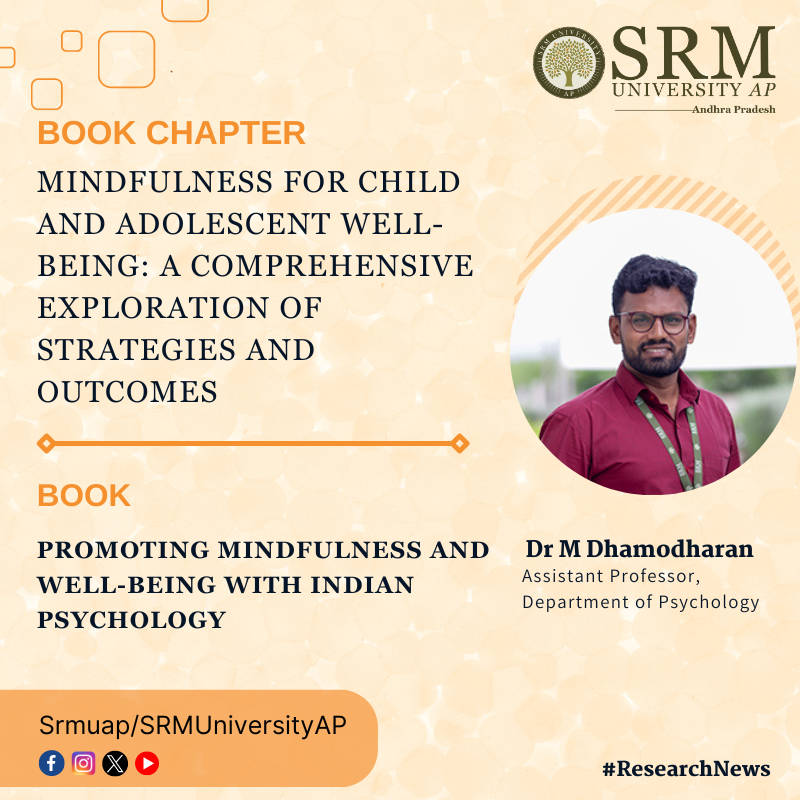
Mindfulness has emerged as a pivotal aspect in the domain of mental health, especially in the context of children and adolescents’ well-being. It refers to an inherent ability to be fully present in the moment, enabling an individual to gain an acute sense of awareness without any biases. Such a state of mindfulness empowers individuals to navigate the ups and downs of life with clarity and composure. Dr M Dhamodharan, an Assistant Professor in the Department of Psychology, has published a book chapter titled “Mindfulness for Child and Adolescent Well-Being: A Comprehensive Exploration of Strategies and Outcomes,” where he has comprehensively explored the intricacies of mindfulness and its impact on children and adolescents.
Here’s an abstract of the chapter published in the book, “Promoting Mindfulness and Well-Being with Indian Psychology.”
About the book chapter
The chapter examines the significant impact of mindfulness on children and adolescents. Mindfulness is the mental state defined by greater concentration, consciousness, and focus on the here and now, free from judgment. This chapter starts with the theoretical background of mindfulness and the current developments of mindfulness related to children’s and adolescents’ wellbeing. There are three main domains focused on mindfulness. Begin with emotional domains—that explains how mindfulness helps to regulate emotions. Secondly, cognitive domains explain how mindfulness practices help cognitive development and academic performance in educational settings. Thirdly, social and interpersonal domains explain the uses of mindfulness to improve social skills and interpersonal relationships with peer groups, family, and society. The chapter concludes with the role of parental and educational institutions in promoting mindfulness among children and adolescents to create a positive impact on their lives.
Dr Dhamodharan’s book chapter is targeted at Educators, parents, counsellors, and mental health specialists who stand to gain invaluable insights from the exploration of mindfulness within these pages.
- Published in Departmental News, News, Psychology News, Research News
Dr Dhamodharan Invited for Workshop on Youth Leadership
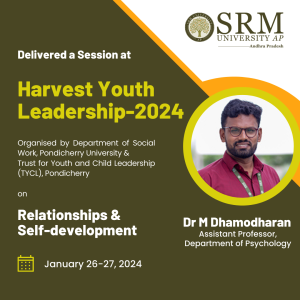 Dr M Dhamodharan, Assistant Professor in the Department of Psychology, was invited as a resource person to deliver a session on “Relationship and Self Development “from January 26-27, 2024, at the Two Days workshop on “Harvesting Youth Leadership-2024.”The workshop was organised by the Department of Social Work at Pondicherry Central University in collaboration with the Trust for Youth and Child Leadership (TYCL), Pondicherry.
Dr M Dhamodharan, Assistant Professor in the Department of Psychology, was invited as a resource person to deliver a session on “Relationship and Self Development “from January 26-27, 2024, at the Two Days workshop on “Harvesting Youth Leadership-2024.”The workshop was organised by the Department of Social Work at Pondicherry Central University in collaboration with the Trust for Youth and Child Leadership (TYCL), Pondicherry.
Dr Dhamodharan’s expertise and insights on the topic added value to the workshop, which aimed to empower young individuals and cultivate leadership skills among the youth. The session provided a platform for participants to delve into the dynamics of relationships and personal growth, essential aspects for nurturing effective leadership qualities.
His contribution towards the event underscored the importance of understanding the link between relationships and self-development in the context of youth leadership.
Abstract
Relationship is a continuing and often committed association between two or more people, as in a family, friendship, marriage, partnership, or other interpersonal links in which the participants influence each other’s thoughts, feelings, and actions (APA,2020).
The connections we set up, the several types of love we meet, and the effects these interactions have on our personal development all have a significant impact on how we live as people. Understanding the many kinds of relationships that exist is the first step in any analysis of relationships.
Every sort of relationship, whether it be sexual or platonic, professional or familial, has its own dynamics, obstacles, and expectations. In the context of human relationships, love manifests as a complex and profound energy. Love affects the core of who we are and transcends cultural barriers in all its manifestations. Numerous love typologies have been proved by academics and psychologists to classify and understand these types. Love has many sides, ranging from the Greek concepts of Agape, Eros, and Philia to contemporary psychiatric theories. This investigation looks at the subtle differences between various kinds of love, emphasising the behavioural, cognitive, and emotional aspects of each.
A foundational work in the field of psychology, Sternberg’s Triangular Theory of Love is at the core of understanding love. According to this theory, love can be viewed as a triangle made up of three essential elements: commitment, passion, and intimacy. It explores the significance of each ingredient and how they interact to shape the different manifestations of love through a thorough investigation of Sternberg’s theory. The talk explains the practical applications, providing a window into how the theory may be used to understand and negotiate the intricacies of real-world interactions.
Furthermore, a comprehensive knowledge of the human experience requires the inclusion of self-development in the conversation about love and relationships. In all their manifestations, relationships function as mirrors that reflect our advantages, disadvantages, and potential growth areas. The reciprocal effects of relationships, love kinds, and self-development are particularly important in human life. Also explains. how people change because of their relationships, moulding and honing their identities to fit the demands of romantic relationships and close relationships.
Finally, this session might give light on the complex interactions that exist between self-development, Sternberg’s Triangular Theory, love categories, and relationship types. Participants may understand more about the complex interplay between love and personal development as well as the enormous impact that connections have on forming our identities by exploring these interconnected domains. This talk might give insightful guidance for the participants to navigating the intricate web of interpersonal interactions, supplying a road map for cultivating meaningful connections and promoting comprehensive self-development.
- Published in Departmental News, News, Psychology News
A Research On Examining Stress Among Adolescents
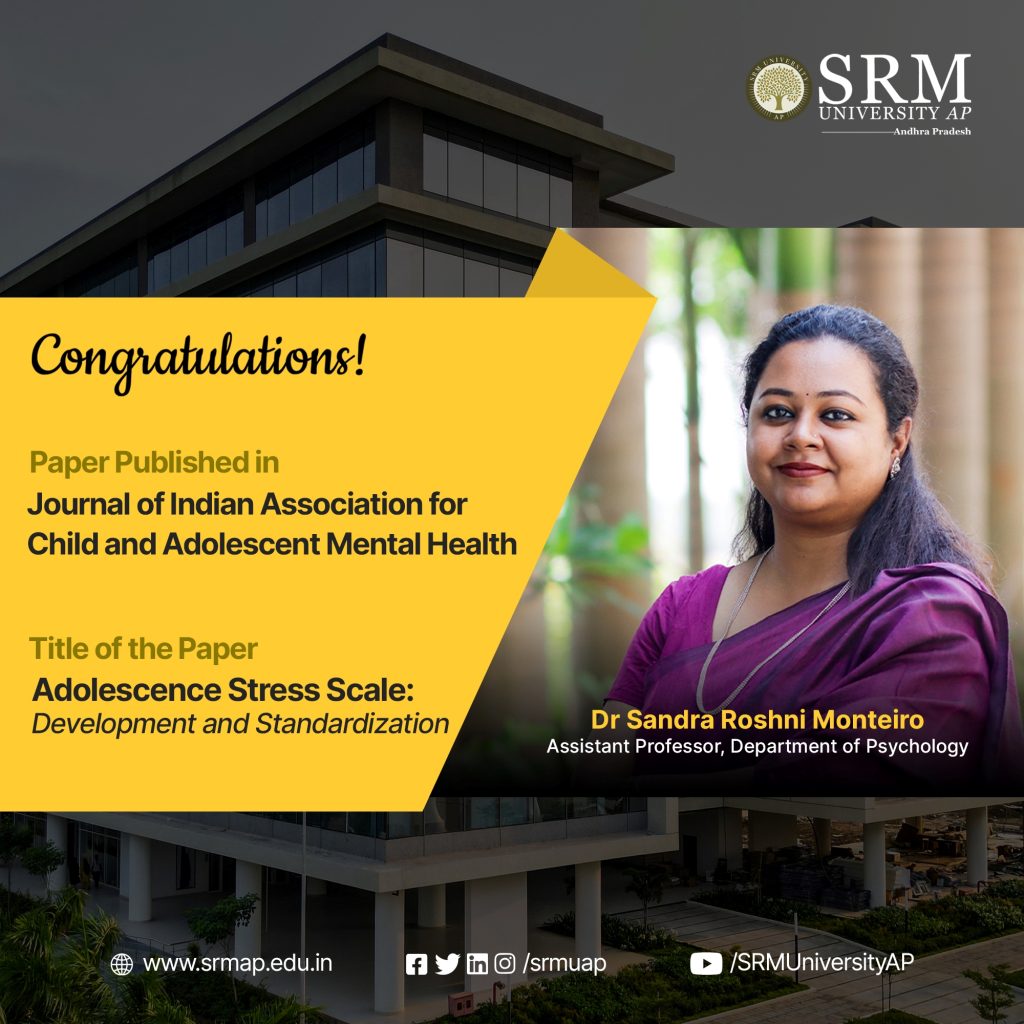
The research paper titled “The Adolescence Stress Scale: Development and Standardization” is a significant contribution to the field of psychology. The paper by Dr Sandra Roshni Monteiro, Assistant Professor at the Department of Psychology in SRM University-AP featured in The Journal of Indian Association for Child and Adolescent Mental Health and provides a detailed account of the development and standardisation of the scale, highlighting its importance and relevance. Dr Monteiro has developed a comprehensive stress scale that aims to evaluate the psychometric issues faced by school-going adolescents.
Here’s a brief extract of the paper.
Abstract
Background/Aim
The objective of the paper was to develop a comprehensive “Adolescence Stress Scale” and to examine different psychometric issues in the development, initial validation, and standardization of this scale.
Method
Exploratory factor analysis was conducted on the data procured from a sample of 634 (11–18 years) school-going adolescents in India.
Results
An exploratory analysis provided a 10-factor structure, namely, major loss-induced stress, enforcement or conflict-induced stress, phobic stress, interpersonal conflict-induced stress, punishment-induced stress, illness and injury-induced stress, performance stress, imposition-induced stress, insecurity-induced stress, and unhealthy environment-induced stress. The 10 oblique factor solutions are found to be interrelated and interdependent with good indices of internal consistency, and content validity.
Conclusions
This scale development is a novel and powerful measure that taps onto various aspects of stress experienced by school-going adolescents. The scale can facilitate researchers, clinicians, and teachers to identify and quantify the significant sources of stress in adolescents in school, or clinic settings.
- Published in Departmental News, News, Psychology News, Research News
Lecture on Marginalised Childhoods
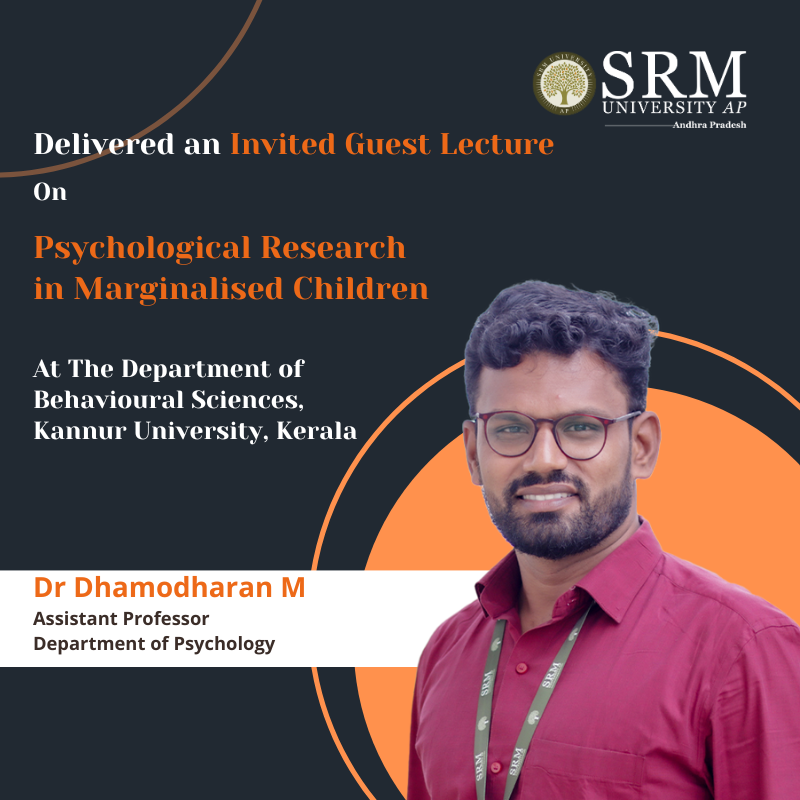
In an insightful talk at the Department of Behavioural Sciences in Kannur University, Dr Dhamodharan M, Assistant Professor at the Department of Psychology, SRM University-AP, shed light on “Psychological Research in Marginalized Children.” Dr Dhamodharan’s talk serves as a call to action, encouraging a deeper exploration of psychological research for the betterment of future generations.
Here’s an abstract of Dr Dhamodharan’s riveting talk.
Abstract
The invited lecture mainly focuses on the status and importance of psychological research in marginalized children. Marginalized People who are excluded from majority social, economic, educational, and/or cultural life. They are excluded due to race, gender identity, sexual orientation, age, physical ability, language, and/or immigration status (Baah et al.,2019). The term marginalized children include Children affected by or emerging from armed conflict or humanitarian crises, Children with disabilities, Children in remote or rural areas (including those who lack access to safe water and sanitation), Religious or ethnic minorities, Orphans, and children affected by HIV/AIDS, Child laborers, Married Children, Victims of trafficking (Legal Information Institute,2023). The World Health Organization defined “Child maltreatment is the abuse and neglect that occurs to children under 18 years of age. It includes all types of physical and emotional ill-treatment, sexual abuse, neglect, negligence, and commercial or other exploitation, which results in actual or potential harm to the child’s health, survival, development, or dignity in the context of a relationship of responsibility, trust or power” (World Health Organization, 2020). Children need essential nutrition, parental care, education, safety, entertainment, medical assistance, and physical, psychological, and social development (Deb & Ray, 2015). Children have their first human contact at home in a pleasant, nurturing, and caring environment; unfortunately, home is also where children are exposed to violence for the first time (United Nations Children’s Fund,2017). All children have the right to be safe from violence, oppression, and abuse. Despite this, globally, millions of children from all socioeconomic backgrounds, religions, cultures, and ages are subjected to violence and abuse daily. Violence against children is typical and endemic, and it is a terrible reality for millions of Indian children.
Over half of the world’s children have been subjected to extreme violence, with South Asia representing 64% of these instances (End Violence against Children | UNICEF India, n.d.) All types of violence against persons under 18 are considered violence against children. In 2019, about 1 billion children under eighteen experienced physical, sexual, or emotional violence or neglect globally (WHO, 2020). In the world, 3 out of 4 children aged 2-4 years were subjected to violent regulation from caregivers daily. Six out of ten children were exposed to physical punishment, one out of every two children aged 2 to 17 experienced some type of violence, and 18% of girl children experienced childhood sexual violence, while 8% of boys experienced the same (UNICEF, 2020; United Nations Children’s Fund, 2017). Victims of child abuse have also been exposed to more than one type of violence (Descartes et al., 2020).
Many countries are not prohibited corporal punishment. One in every two children aged 6 to 17 is subjected to corporal punishment. Around fifteen million girls aged 15 to 19 have been subjected to forced sex from partners, boyfriends, or husbands, with just one percent seeking professional help. Throughout the world, 1 in every three children aged 13 to 15 has experienced bullying at school. Girls face more psychological bullying than boys, whereas boys face more physical bullying than girls (UNICEF, 2020. Sexual assault and exploitation are the most common violence in slum regions. Those in positions of supremacy and authority, such as educators and leaders, are the primary perpetrators. Early pregnancy is also a serious concern among the underprivileged community, which leads to sexual exploitation (Nagasurendran, 2017).
Approximately 70 lakh children in India are not receiving all vaccinations, particularly in slum areas, migrant settlement areas such as fisher villages, construction sites, and inaccessible villages. This data is very high compared to all other countries globally. Proper childhood nutrition is a significant indicator of development and welfare, especially in developing countries. However, previous literature studies failed to focus on the children from the marginalized communities. The students from Psychology background need to explore the marginalized children’s health, education, and mental health. Furthermore, the marginalized children study findings would be an eye-opener for the social welfare department to take need-based welfare measures for marginalized children.
Current Status of Research
- Convenience sampling procedures overrepresent dominant groups (Rad et al., 2018)
- Only 5% of articles in one premier psychology journal predominately sampled ethnic minorities (Thalmayer et al., 2020)
- Less than 2% of psychological studies across three decades of research included sexual minorities as participants (Lee & Crawford, 2021)
Major Challenges faced by Marginalisation Children
- Health Issues – Malnutrition, Lack of healthcare facilities
- Lack of Educational Support
- Abuse and Violence
- Lack of Social Support
- Caste Discrimination
Areas to Study in Marginalization Children
- Discrimination in School and Community (Deb, 2019)
- Resilience and coping mechanisms (Dar,2020)
- Educational motivation and Teacher-student relationships (Martin,2020)
- Traumatic and Post Traumatic Stress (Szota,2023)
- Identity Formation (Yosef,2023)
- Social Support and Media Influence (Kaskazi,2023)
- Published in Departmental News, News, Psychology News


